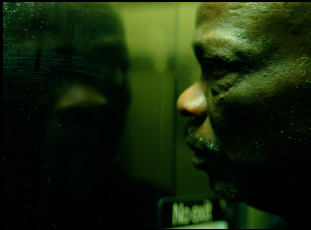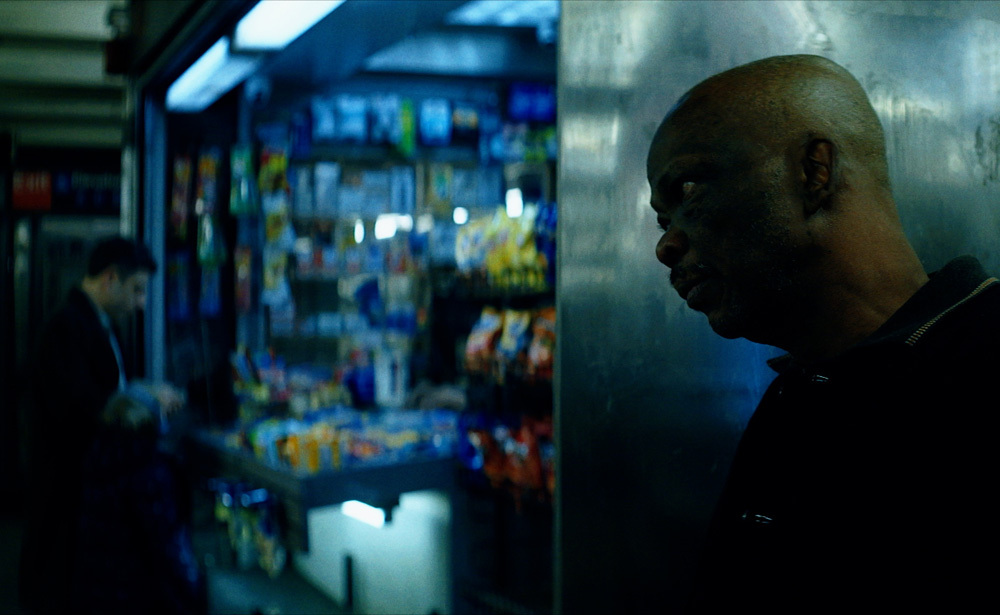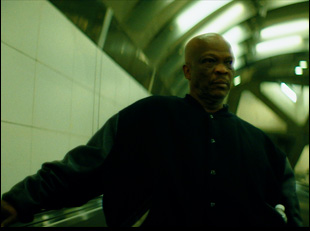When “Shotplayer” was first conceived, it might not have seemed all that complicated – a short documentary film that would revolve around one subject in one location, only that location would be the New York Subway System where director Sam Shainberg would be following around the city’s most infamous pickpocket Willfred Rose, a task made all the more difficult in a post-COVID landscape.
“Among my pals, it’s a bit of a legendary shoot,” says Shainberg, who lived to tell the tale. “It was four or five days of basically walking 50 miles inside the subway system and we rode countless trains end to end, and every piece of equipment was carried on our backs or in a wagon. It was just bananas.”
Rose is retired from his unusual line of work when Shainberg asks him to tuck back into the tunnels where he once plied his trade, a profession he picked up at 13 after resettling in Harlem after his family moved from the Virgin Islands. As he describes all the preparations for theft as “a habit took me over so much I couldn’t stop,” overhearing intimate conversations or locating a certain angle on a specific mark, it becomes just as seductive in Shainberg’s eyes, delivering the vicarious thrills of of a heist minus the guilt that weighs on Rose for being so skilled at pulling them off. But when he compares the subways to the jungle, “Shotplayer” imagines the underground as being just as wild as Rose stealthily navigates busy thoroughfares and hidden backchannels that come to reflect the soul-searching he’s needed to do in reflecting on what he’s done.
More provocatively, however, Shainberg demands an audience to do the same when lurking about beneath the surface becomes emblematic of Rose’s place on the social strata, hustling as a means of survival and asserting himself among those who lead far more comfortable lives for reasons having little to do with anything besides the luck of where they happened to be born and as he listens in on others go about their days with fewer worries than he has, it feels like he’s stealing time for himself when he can think of his wife or family rather than what he has to do to support them. “Shotplayer” elevates Rose, who sadly passed away shortly after the production, to the leading man status he saw for himself, even when he was so obviously marginalized by expressing as much confidence as he did during his heyday, executed in long, fluid tracking shots and bathed in bewitching light.
As the film made its premiere at SXSW, Shainberg graciously took the time to talk about how he went about honoring Rose’s restless spirit after all the trouble he went to in order to find his wily subject in the first place, turning the MTA into a massive set and blending fiction and nonfiction elements into a film that conjures inescapable realities.
There’s a whole saga that begins pre-pandemic where a colleague of mine gave me an article that mentioned Willfred and the changing nature of crime in New York, in particular the dying art of pickpocketing. It stuck with both of us, and we [thought], “Let’s try to find it. This seems like an interesting potential film.” Then the process of finding [Willfred] took a year. We started with the journalist who gave us a phone number that was dead, totally useless, and then we met two other pickpockets that had been in the press and well-known to the NYPD. Neither of them were people I wanted to spend a lot of time with, because we didn’t jive immediately, but they both confirmed that Willfred was the one that we wanted. They both said things that added to his mythological quality.
Then I met Nelson Dones, the NYPD’s big pickpocket hunter who knew them all by on sight and would go out in costume and played this cat-and-mouse game with them for years. He’s in the movie — he’s the cop with the angular face — and he said to me, you’ve got to get [Willfred’s] last known address, and one of my producers found an address online. We went and talked to him, and then we became really fast friends, and I think he was hungry for to talk about all that time with someone because everyone in his life knew what he did, but I don’t think they were listening to the many ins and outs and the tales of the trade that almost inevitably give way to [a feeling of] guilt and self-reflection around that, so there was some catharsis.
We’re about one week from shooting when New York closed because of COVID-19, and when we were scouting, every night we were having this conversation, “Do you think we can pull this off? Are we endangering the crew or the subjects?” Of course, the city closed, and we put the movie on hold until [after] “Endless Sea,” my last film, and [we] won a great many prizes and grants [with that], so we realized, “Oh, we have a great movie we’ve been trying to make and all these grants come with time limits,” so it was really felt meant to be.
How did you scope things out when this moves through the subway system so fluidly?
I would love to behave like it’s some visionary idea of mine, but it was born of necessity, because Willfred wasn’t comfortable walking and talking in front of the camera, but he was happy to act physically. Our interviews were so wonderful and easy and flowing that it was a matter of how do we combine these things and make it visual? He’s not a trained actor, so that was all new. Then, as far as scouting goes, the subway is, in the visual sense, his inner space, so we wanted to make it this beautiful place, or at least see it in a way you’ve never seen it before. That’s why we were to unbelievable lengths to light things in the subway and take over locations you haven’t seen.
Rachel [Walden], the producer, and myself had so much stress and anxiety about getting immediately shut down left and right, but that couldn’t have been further from the truth. All that lost sleep was unnecessary, because the city opened its arms to us. People on the train were into it, and without fail, it was all just awesome. There was even a moment when there was a pretty intense-looking guy, and I had to ask him to move, and I was nervous, but he looked up from his headphones and his phone, and he got so into it that he started filming us filming. He’s like, “Oh, yeah, I gotta film for my boy. This is crazy, like you people are nuts.” We had people riding past their stops [to see what was happening], and the cops were engaged in some work stoppage in New York, so they were not concerned with anything they didn’t deem absolutely necessary, so they were just pretty much checked out. And we stayed out of way of the MTA workers and tried to let the trains run on time while doing our thing. Everybody just pitched in in such a phenomenal way. We have this great gaffer Connor Schuurmans, and all these people jumping in, [and] it was a full commitment from everyone involved, which is really, to me was one of the most special things.
Willfred does have this beautiful voiceover – did you have a lot of that recorded from interviews before filming in the subway or did that come after?
It was a continuous process that I almost don’t feel finished with now, but all films end, and we did these long, rambling interviews, and when we got transcripts, I wrote a script with story input from Willie Miesmer, using his voice and the visuals we’d imagined and planned. We made a radio edit and then we shot and when we started to cut, we started to put his voice in and it had to change repeatedly. Certain scenes didn’t work, and [others] needed to be illuminated, and I really felt strongly that we needed to touch on the fact that [pickpocketing] had an addictive quality for him. I love that line where he says, “I love to feel invisible, but not the way most black men feel invisible, but like a hunter.” Even from really early on, I felt he was like Ellison’s “Invisible Man.” He grew up in Harlem around the Apollo, but as a pickpocket, he existed on this invisible plane of his choice, so these lines haunted my nights, and they kept changing. I probably will never make a movie like that again, where the [voice over] work is like piecing together a puzzle.

I wanted to go deeper, and there’s that collage piece when it’s like we dive into the subway [where] my hope is that there’s a feeling of entering [Willfred’s] psyche as you go into the subway [because] you might notice we only go down — we go down the stairs, down the escalator, down into his psyche and into his thoughts. And that’s one of the deeper — and sweeter — parts where he talks about his wife and how they met, and how his life as a criminal played on his relationship.
I love Wong Kar Wai, and that [scene] is straight “Chungking Express,” but it just like felt right. Daniel [Zuniga, the cinematographer] and I actually talked about it a lot, and that day I said to [him], “What can we do in camera right now?” And we shot like three or four shots of that young couple [played by] Bertha Mwambagi and Al’urdan Islam, who were awesome. They’re not a real couple, they’re just two great actors, and we just shot a couple test shots, and we just did it, and I loved it. It was great.
Was there anything that happened that changed your ideas of what this could be?
The biggest was that this is no “Taste of Cherry,” but we had a Kiarostami-level problem with the ending, [since it was] planned that you would see the young couple [which are] his memories, and they stand in for the wife and then his real wife, Grace would be on the train and then later, his family would be present at the house in the ending, in a more verite style. But Grace is not terribly well and her energy wasn’t up for this level of madness that any film takes, so we didn’t get that ending. But on the first day, Daniel, the cinematographer who’s so magical and amazing, shot those portraits of Willfred and Grace that were originally supposed to be part of the beginning, but I [realized] “Let’s get moving [at the start] and I didn’t have anywhere to use these portraits. In the end, not only did they save us, but they made a better ending and I was still talking about adding a day to shoot an ending, but no, the water on the canvas just had to be mixed in to make it great and between Daniel shooting them and Luca [Balser], the editor, recognizing that, it’s amazing. It was meant to happen.
What’s it been like to get to this point with it after carrying it with you for some time?
I’m really happy. I’m also really sad because Willfred passed away, and it’s the loss of a really good friend and it’s really hard for Grace and his family, so it’s a lot. Willfred saw cuts [before he passed], and his son, Donald has seen the movie, and I think we’re just waiting for Grace’s mourning period [to show it to her], just being delicate around that. And as a filmmaker, it’s great to [think], “Okay, it’s done. I birthed a child and it’s going to walk and talk on its own now.” But there’s a bittersweet nature to him not being here for the premiere and the finishing is always hard for me. I am a ball of fire and energy until the rough cut and the first polish is done, but those last hard yards are really hard for me. I think [movies] break your heart, and you fall in love again, and they break your heart again, so there’s no small answer to this. It’s great to get it out there, and I’m sad Willfred isn’t going to be around for that, although I know that he felt good about it.
It seems you made something beautiful that he can be remembered by.
Yeah, it’s like a mausoleum, right? A pyramid that never goes away. A movie is timeless in that sense.
“Shotplayer” does not yet have U.S. distribution.





